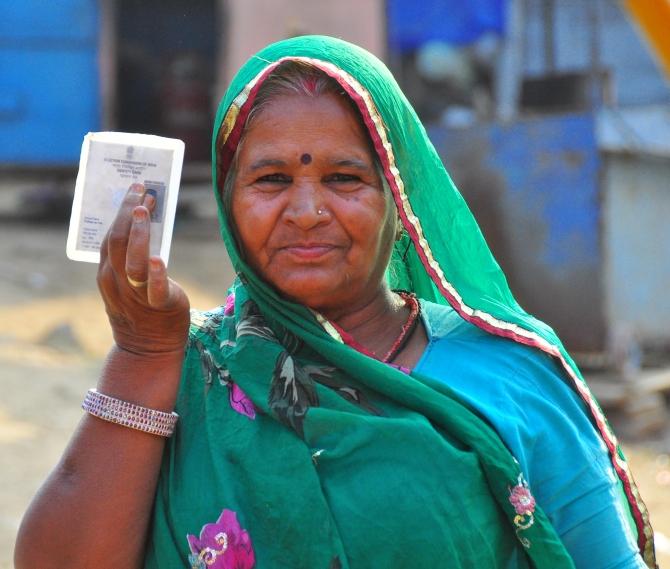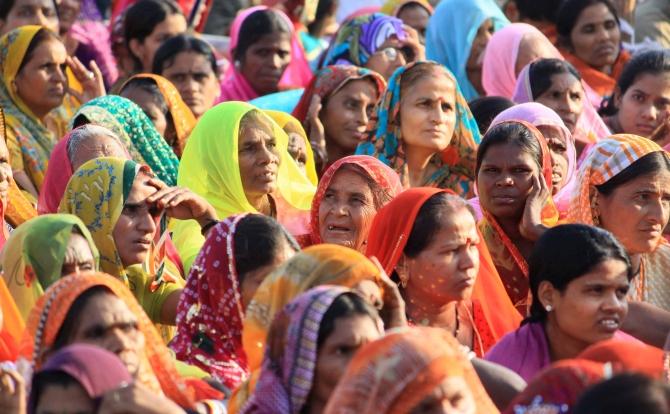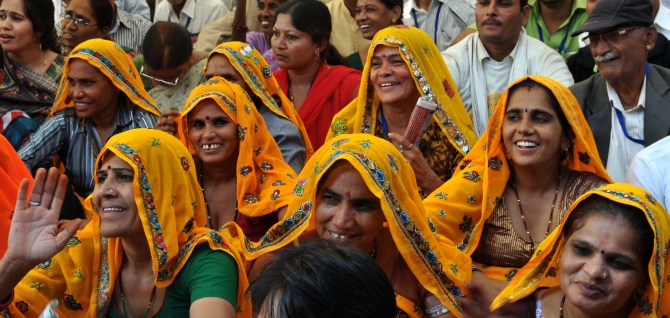Photographs: Chandra Mohan Aloria
Where other Indian states cry for women representatives in assemblies and other elected bodies, Rajasthan has highest number of women legislators and sarpanchs (village heads), but the recent electoral list shows drastic decline of female voters in the desert state.
In 2008, as many as 28 women (14 per cent) had been elected for the first time in Rajasthan assembly elections. Two years later, more women (52.73 per cent) than men were elected as sarpanchs; thereby, leading to a perception that the desert state was warming up towards the fairer sex.
But five years down the line, the State Election Commission records suggests major decline in the gender ratio of voters.
Now, Rajasthan -- the largest state of India is all geared up for its forthcoming assembly polls such a gaping irony is becoming a much-talked-about issue. Despite women representation in the state assembly being on the rise, coming elections for every thousand male voters only 897 women voters will caste their franchise in comparison to its 2008, when gender ratio of voters was 906.
According to the Rajasthan election commission, for the 2013 assembly electios, there are total 4.6 crore voters and among them 2 crore are male and around 1.9 female voters in desert state.
This comes as a bad news for a state already having a skewed sex ratio of 926 per 1,000 males, which, is much below than the national average of 940 women per 1,000 men.
The phenomenal drop in ratio has become a new issue has landed the state in an embarrassing situation.
“It is a matter of great concern to us also as we had conducted Systematic Voter Education and Electoral Participation programme and had tried to insure maximum enrollment of voters. But then also we are getting such figures,” rued Dinesh Mathur, a Rajasthan Election Commission official.
...
The great contradiction about women voters in Rajasthan
Image: Rajasthani women in a political rallyPhotographs: Chandra Mohan Aloria
Among the five Indian states going into polls -- Rajasthan, Madhya Pradesh, Delhi, Chhattisgarh and Mizoram -- according to election commission, the desert state has highest fall of gender ratio in comparison to previous election.
While Mizoram, a Indian state where matriarchal society prevails, women have outnumbered male voters with a 10:10.38 ratio. While for every 1000 male voters, Madhya Pradesh, Chhattisgarh and Delhi have 897.46, 964 and 804 women respectively. Despite being the capital, Delhi has the lowest male-female voter ratio.
Social activist Aruna Roy, who has fought many battles for women rights in India, feels that lack of transparency in the way of election commission’s functioning could be one of the main reasons. She believes that there is a bigger conspiracy here as many a time the officials remove female voters from the electoral lists for myriad reasons.
“There is no transparency in removing names of voters from the electoral list. I have observed that at a village level families get their female member’s name removed from the list without any reason, without the matter getting reported,” she said.
She even shared her own experience when her name registered in a village in Rajasthan was removed from the list. “Many a time during elections I have found my name missing from the list, it keeps coming and disappearing just like magic,” she chuckled.
Interestingly, where Roy is pointing out removal of women names as a practice mostly in the rural areas, the state has around 4,834 women sarpanchs in comparison to 4,332 male sarpanchs in the villages.
In 2010, Rajasthan became the first state to reserve 50 per cent seats for female candidates. And some women also won seats from unreserved seats which shot the percentage to an astonishing 52.73 mark.
On being asked the reason for decline in women voters in rural belt, Chhavi Rajawat, an MBA who ditched her career to become a sarpanch in a village in Rajasthan shied away from answering the question.
...
The great contradiction about women voters in Rajasthan
Image: Women at a rally in RajasthanPhotographs: Chandra Mohan Aloria
“I will be able to comment on this only after discussing the issue with the female folks of my village,” said Rajawat.
While Roy talked about transparency, some blamed on social evils like child marriage and female foeticide or the trend of not letting females inherit properties, as the reason for the declining numbers.
“More than removing names from list, most families prefer to refrain from getting females members registered in voter list. This is done to deprive women from getting their share in family properties,” states Rajiv Gupta, a social scientist and professor in RajasthanUniversity.
As indicated by many, child marriage, another issue that plagues Rajasthan further dents the ratio. The chairperson of Rajasthan state commission for women Lad Kumari Jain said, “Child marriages are still done illegally in rural Rajasthan, so for many parents the question of enrolling their daughters name into voter list does not rise. On the other hand her in-laws fearing it as a potential legal document in case of family disputes related to properties refrain from getting their daughters- in-law registered as voters.”
Gupta adds another dimension to this issue by stating that due to child marriages being a reality in Rajasthan, a large number of women die during their natal and post natal period.
“Such untimely deaths further reduce number of women voters,” highlights Gupta. While Roy connects it with another important issue of the state, “Crime and violence against women is continued in Rajasthan and that could have affected the ratio.”
She does have a point here, for data from the National Crime Records Bureau reports reveal Rajasthan reported 63.75 per cent cases of crime against women in 2012 alone. Rajasthan stands third in India as far as crimes against women are concern.
While activists and researchers are revealing many reasons to explain the decline in gender ratio of voter list, activist Rajan Choudhary, who has helped state government to conduct more than two dozens decoy operations to curb the illegal practice of sex determination in nursing homes, asserted that female feoticide was one of the prime reasons for the dwindling numbers.
Figures reveal that in Rajasthan, the child sex ratio (0 to 6 years) was 916 in 1991, which gone down to 883 in 2011.
“Rampant female feticide is a major factor for the lesser number of female voters. Since 1991 the sex ratio has been dipping in a sustained way due to female foeticide. Crimes committed against girl child for a period of three decades is now being reflected in the voters list too,” stressed Choudhary.
TOP photo features you missed last week
...




article